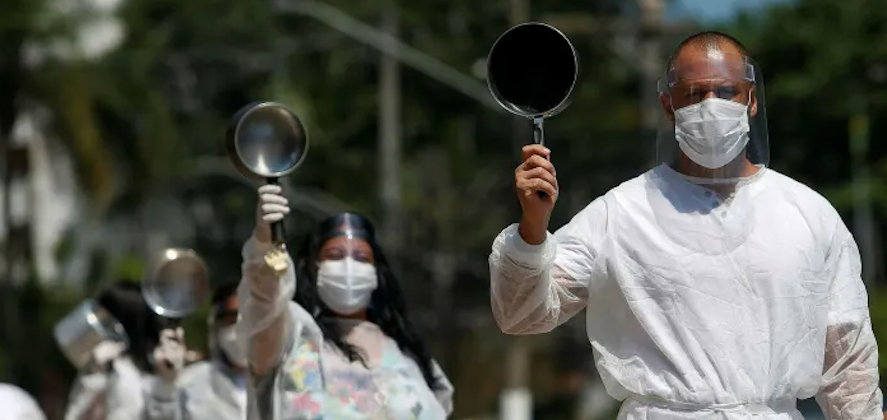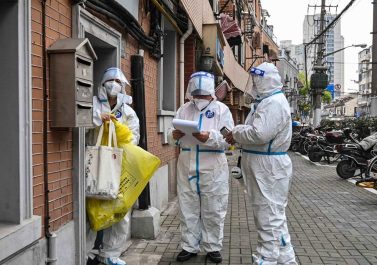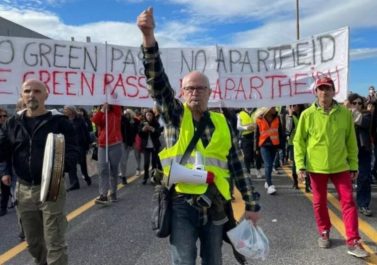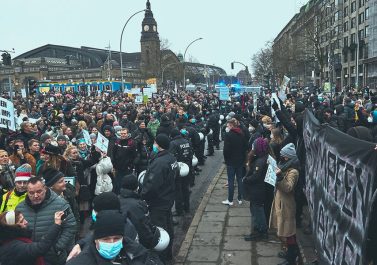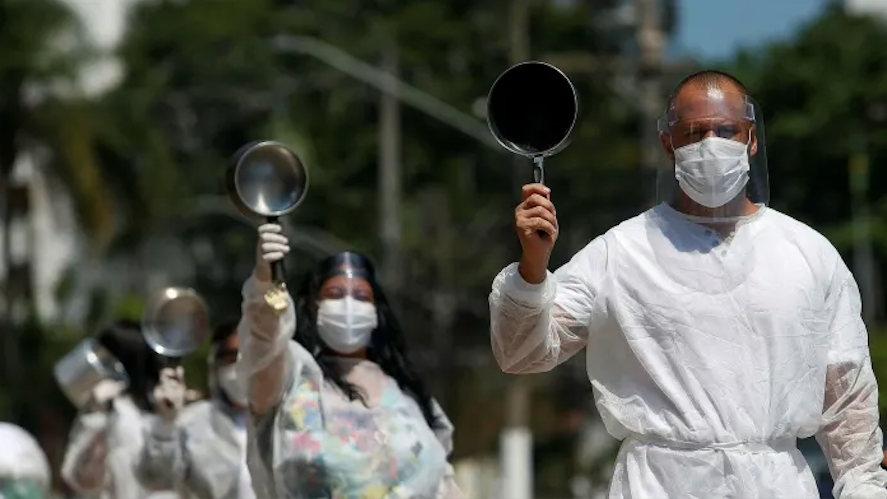
A comrade from Brazil sent us this detailed report about cross-class protests against the lockdown. The article was written in January 2021, before the rapid and fatal expansion of the pandemic. It is nevertheless an interesting observation of the material basis of cross-class ‘popular’ protests and their problematic outcomes. In addition to the health crisis inflation has been soaring since spring 2021. The FT wrote on the 11th of April: “On a 12-month basis, inflation in June is expected to surpass 8 per cent, far above earlier estimates. In the 12 months to March, food prices jumped 18.5 per cent, while the price of agricultural commodities in local currency surged 55 per cent and the cost of fuel increased almost 92 per cent.“
It won’t close! It won’t close!
An enraged crowd of businesspeople, shopkeepers, street vendors, tourism workers, craft sellers and residents of Búzios shouted on December 18 against the court decision banning tourists from entering the city at the end of the year.
We want to work! We want to work!
Another angry crowd shouted in downtown Manaus on December 26, against the lockdown decree that prohibited economic activities such as commerce, artistic performances and restaurants. The crowd blocked traffic while allowing buses to pass because “they carried workers”. Then they barricaded themselves and confronted the police in front of the TV broadcaster A Crítica, which “did not speak the truth about the reality of the lockdown”.
***
“If the public authorities do not give some oxygen to the companies, we will have another problem, a lot of bankruptcies”, said businessman Marcos Casarin, president of the CDL (Shopkeepers Association), according to the newspaper Folha de São Paulo It will be “total chaos”.
Três Lagoas, Montes Claros, Juiz de Fora, Búzios, Angra dos Reis, Manaus, Olímpia: these are some of the cities that have been shaken by protests against restrictions on economic activities due to COVID-19. These protests mobilized in different ways artists, businesspeople, their employees, precarious workers, street vendors, and self-employed workers. I will hardly be able to give a complete picture of what has happened — so I will provide a summary and talk about some issues that catch our attention regarding this mobilization that sounds, smells and looks a lot like a popular revolt against governments. First a brief typology of what has happened so far.
Orderly mobilization directed by businesspeople
In Três Lagoas, there was the mobilization model completely controlled by bosses affected by the economic measures and the workers who will be affected as a result. An orderly demonstration, with few people and posters, gathered in front of the city hall and took pictures with the municipal guard.
In Pipa and São Miguel do Gostoso there was also another model of relatively orderly demonstration — with the difference of being in defiance of a court order to cancel an event. Most of the protesters were employees or people directly dependent on the events ran by the businesspeople who are ahead of the protest. They close a highway in Goianinha, but with a large number of uniformed employees of the event and knowing that victory was guaranteed. They won, the judiciary backed down, and they held the event.
“Unified” demonstrations made by workers and business owners
In Juiz de Fora and Montes Claros there were unified demonstrations carried out by shopkeepers, restaurant owners and workers from the music and entertainment sectors. The demonstrations led crowds to the streets with signs such as “free artists”, “free musicians” demanding the end of lockdown restrictions, but also showing the difficult reality of the workers in those sectors. There are many contradictions, though. In Juiz de Fora, the lockdown was suspended, and many activities were allowed to continue.
In Montes Claros, the bars were allowed to open, and the artists have also managed to guarantee any presentation to a maximum of two artists at a time.
Official insubordination
At least 20 cities in São Paulo refused to change their Covid-19 risk to red and kept businesses open normally, in a clear challenge to João Dória’s state decree. They will be notified and can be held accountable in courts.
The same situation happened in Búzios (Rio de Janeiro state), where a court decision restricted tourism in the city due to the city hall failure to comply with a Conduct Adjustment Agreement (TAC) in order to ensure the health of the population. The city hall filed an appeal and openly stated that the court order was unfair. The result was a movement that broke out from the institutions.
Popular Revolt
The demonstrations unify entrepreneurs, workers employed by these entrepreneurs and a number of other workers such as couriers, self-employed workers, motorcycle taxi drivers, street vendors and others who show some political independence and have no direct link with entrepreneurs. Such different composition of the “movement” gives a different feature to the protests, making them more uncontrolled and confrontational. It was what happened in Manaus, Angra dos Reis and Búzios.
The name popular revolt is not due to a positive feature derived from popular but from the similarity with the protests that became widespread in June 2013 and, beyond this wave of protests, are present in the struggles for urban public transport that are part of the daily life of large Brazilian cities. As Leonardo Cordeiro and Caio Martins Ferreira stated in the text Popular Revolt: the limit of tactics, popular revolts are:
“a short, although explosive, intense, radical and decentralized process”. The first demonstrations act as a spark, leading to a mobilization that cannot be controlled or interrupted by those who initiated it. There is an escalation of direct action: massive occupation and blocking of important streets in the city, confrontation with the police, attacks on public and private property, looting. By undermining the circulation of value and threatening to unleash chaos — widespread disobedience – the protests, which do not answer to a representative with whom a negotiation is possible, force the government to retreat in order to restore “order”.
BÚZIOS
Búzios set off the fire alarm. On December 17, a decree was issued by the court forcing the city to resume the lockdown. According to the newspaper O Dia:
“The court decision is based on a Conduct Adjustment Agreement concluded with the Public Defender’s office in June 2020, and that would not have been fulfilled so far. On the occasion, for example, the municipality committed, for example, to have 17 ICU beds for the treatment of Covid patients, but there are only 11”.
The city hall claimed that it was going to appeal against the decision. But something unexpected happened on December 18th. A crowd comprising business owners, artists, crafts sellers, residents, and other people who depend economically on the activities that would be prohibited by the decree were on the streets shouting “it won’t close!”.
Although the main beneficiaries were the business owners and the mayor, who was against the lockdown, the video recording and the form of expression (there was no sound truck centralizing the slogans, for example) showed that there was a greater diversity and amplitude than just these interested parties. In addition, different from the demonstrations in Pipa, for example, there was not a large presence of workers wearing company uniforms. Take for example this footage of the march that occupied the main avenue of the city. The demonstration became more radical when people practically occupied the court where the judge who had decided for the lockdown was and surrounded the employees, as shown in this other footage.
On the same day of the demonstration, the court retreated and allowed the activities to continue. It won’t close was the protest slogan, and it did not close. It became “the example of Búzios” in the narrative of what was now beginning to assert itself as a movement. Who won? The mayor, who did not need to provide the conditions for dealing with the pandemic. Business owners, who assured their profits. The population that managed to survive without any alternative. The attempt to impose the sanitary condition without any dialogue and alternatives was defeated. The fight to save lives also lose.
The Angra dos Reis Revolt
In Angra dos Reis the situation had already changed because of Búzios, a successful revolt had just happened in Manaus and the movement had a national articulation around the controversial hashtag #AglomeraBrasil.
Angra dos Reis city hall issued a decree suspending tourism activities, bars, restaurants, and religious temples. It only partially restricted some tourism activities. The decree can be checked here.
Once again, the protest against any restrictions ended up involving much more than just business owners and their employees. They used a tactic that is often used by left-wing students of the UFRRJ (Rio de Janeiro Rural Federal University), which is to close the Rio – Santos Highway. Here it is possible to watch a footage of the protest that shows the diversity in the composition of the demonstration: there are shopkeepers, but there are also self-employed workers who depend on tourism as independent economic agents.
The popular revolt of December 26 in Manaus
Let’s start with the decree of December 23. Issued “in a hurry” by the Wilson Lima (PSC) government, which was seen as indifferent toward the pandemic at other times, the decree banned — during the period of greater profitability, when many people manage to save some money — the activities of commerce, restaurants and any sale of materials by street vendors — thus affecting a significant amount of people. It is important to point out that these businesses and restaurants have, in turn, several informal workers among their direct dependents, in addition to the formal employees. Well — why did all of this caused such a revolt at that moment and why things exploded just in Manaus?
Formal employment has been declining in the city of Manaus since 2015. This image shows the evolution of formal employment in recent decades in the city, and the evolution has not been favoring the formal employees in the city.
In addition, the state of Amazonas is a national champion regarding the proportion of informal workers. There are only 819,000 formal workers among the 1.55 million employed people in the state. In Manaus, of the 873,000 people employed in 2019, 333,000 were in informality: 38.2% of workers. The trend this year suggests that this share has increased due to the pandemic. There are 636,000 beneficiaries of the emergency aid in Manaus, a government benefit that formally ended in December. Many people must have invested such money in a small enterprise in an attempt to make some money at the end of the year in order to try to survive in the hard times that will come. These people saw such source of income disappear and were left without any alternative.
For these reasons, and not because of pandemic denialism or stupidity, but out of sheer necessity, that there was a crowd of workers together with business owners in downtown Manaus on December 26 blocking traffic during the whole day in several roads and making barricades until the governor retreated.
This unified mobilization between informal workers, precarious workers, shopkeepers and business owners was synthesized in the “Movimento Todos por Amazonas — MTA”. As described by Serafim Taveira in the Jornal Conservador:
“The decree caused concerns and immediate disgust in several segments of the population that depend on the functioning of economic activities, such as the sector of transport performed by professionals known as rideshare drivers and taxi drivers, and the employees and owners of the local businesses that are included in the list of non-essential services.
The immediate despair was so great that the articulation of the people who sought the same goal, the end of the decree, occurred with an unprecedented high speed and resulted in the actions that blocked the roundabout of the farmer’s market in the east side of Manaus on 26/12/2020 and the roundabout of the Gilberto Mestrinho Road complex that is located at the intersection of the east, south and center-south zones. The movement grew, showing a public face and defining goals. Now it is known by the acronym MTA or simply Movimento Todos por Amazonas”.
Some people stood out in the movement, and they do not necessarily have a deep prior bond with political parties. Victor Feitosa, rideshare driver; Ivanilson Duarte, entrepreneur in the food business in the East Zone; Silvio Maia, employee in a company; Romão Júnior and Dowglas Soares, accountants.
Faced with the new lockdown, the movement (MTA) tried to organize a new demonstration on January 05 with the following demands:
NO LOCKDOWN
FREE COVID-19 KIT (Ivermectin, Multivitamins, Azithromycin, Prednisolone)
BETTER WORKING CONDITIONS FOR HEALTH PROFESSIONALS!
BALANCE BETWEEN ECONOMY AND HEALTH!
MORE TRANSPARENCY IN STATE PROCUREMENT WEBSITES, DISCLOSE PURCHASE VALUES AND SUPPLIERS
Nobody attended the demonstration, but the conversations continued to happen. There is no evidence that the movement has carried out any relevant negotiations with the government either – the negotiations have been carried out mainly by business entities. The movement has been above all a space for mobilizing people. What I want to emphasize with this explanation of the foundation and form of the movement is that it is not made of manipulated and ignorant people, and that it has some roots among urban workers and considers itself legitimate.
Even so… a victory for the movement?
Governor Wilson Lima announced an incentive package and fiscal measures in the amount of R$ 140 million — after being forced by the protests to give up of the lockdown. Some announced measures are:
– ICMS (state tax) reduction of 3.5% to 2%
– Postponement of tax collection
– Suspension for 60 days of subpoenas and notifications of tax auditors; as well as deadlines for infringement notices, as well as acts of registration of active debt and tax enforcement claims.
– Emergency line of credit from the Amazon State Development Agency (Afeam), in the amount of R$ 140 million, for micro, small and medium enterprises, liberal professionals and farmers
The mayor of Manaus, who had criticized the Governor Wilson Lima for the lockdown asking “why it had not been done before” and had promised to distribute medicines against COVID-19, also had to take some measures. He decreed a 180-day state of emergency instituting telecommuting and, more significantly, prohibited the disconnection of water or sewage service due to lack of payment until March 31, 2021, for the poorest users who are enrolled in the social tariff programs. The city Public Education System that was planning to resume classes in January had to back down and announced a possible return only in March.
It was not a surprise, since the situation regarding the COVID-19 pandemic is serious. The city hall had to announce an increase in the number of burial drawers in cemeteries, cold rooms were installed in hospitals to deal with excess bodies and cemeteries even had a queue of hearses.
Does it mean that the situation is pacified? Far from it. Although the demonstration called for January 5 was unsuccessful, perhaps because of a fear manifested in the multiple requests for preventive habeas corpus for protesters, there were threats to public authorities such as judges and governors in the mobilization and revolt groups in the city.
Lockdown dilemmas
When the movement speaks about the “balance between economy and health” it is talking about a simple reality: it is not possible to stay at home and take care of people’s health without the proper conditions. Why was it necessary to carry out demonstrations, close highways and make barricades for the governor and the mayor to take these basic measures that minimally help people to stay at home? People need to eat and need to take care of their health. Those things cannot be in opposition to one another A lockdown without social and economic protection measures is a repressive farce. People will revolt against such a situation — and it will be a legitimate revolt. It is up to the left to understand this and demand social protection measures in order to reassure the protection of the health of poor people who depend on their own economic activities.
On the other hand, the problem concerning informal workers still persists. Most of the announced economic measures are focused on microentrepreneurs (self-employed workers who formally own a small business) and registered liberal professionals. Street vendors were still prohibited from carrying out their activities, and were without an alternative source of income. A possible and concrete option is the proposal made by the mayor of Belém, Edmilson Rodrigues, the “Bora Belém”, a basic income for those who cannot generate the income necessary to survive during the pandemic. If proposals focused on the specific vulnerabilities suffered by informal workers are not put into discussion, other uprisings directed and appropriated by the right and by business owners interested in the end of any sanitary measure will inevitably break out.
It is up to us to dialogue with people, understanding their life and survival processes and helping them to go through this situation.
P.S.: traces worth investigating
An evangelical connection with the #AglomeraBrasil movement
The prohibition or partial restriction of the functioning of religious temples was present in the decrees in Angra dos Reis, Búzios, and Manaus, but there was no explicit mention of pastors or evangelical leaders participating in the demonstrations. However, there are some traces of a discreet support on the internet.
The hashtag, created to explicitly challenge the lockdown decrees, was not explicitly supported by any right-wing media. The main exception is the website pleno.news, which published the following news: “Internet defies lockdown and launches the campaign Aglomera Brasil” It is the most shared news on the subject (except for the left-wing news that repudiate it) and is practically an editorial in support of the campaign, strengthening the mobilization for it to continue.
But what is the pleno.news website? The website introduces itself by stating that:
“Pleno.News is a digital-focused news website that operates independently. Officially launched in August 2017, the website aims to be a safe reference for content, especially at the time of profusion of fake news. (…) The editorial line is family-safe, safe for the whole family, a gap in current journalism and a demand made by the audience, which is not represented by media groups”.
Marco Feliciano, Renato Vargens, Elizete Malafaia, Bia Kicis, Arolde de Oliveira and Edvaldo Oliveira are among its columnists
The website is part of the MK Communication Group. Marina de Oliveira de Menezes and Yvelise Assis Vieira de Oliveira are business partners of most of the MK enterprises, especially those that have the same address as the pleno.news website. MK business portfolio is extensive and comprises: software development, a radio, two different church websites, data processing, brokerage and agency activities, CD and DVD retail and wholesale.
One of the businesses that has the same address as Pleno News, Rua Gotemburgo, 211 São Cristóvão — Rio de Janeiro, is called Kronos MK and develops digital management software for churches, which ranges from shepherding members to issuing digital cards.
The most shared news produced by pleno.news deal with two issues — Bolsonaro’s projects and criticism of the lockdown policy applied during the pandemic. The biggest enthusiast of the website on Facebook is Marco Feliciano.
Now, what is the connection between a website that boasts among its assets 14 million visits and 5 million visitors due to its perspective of Family safe content and a hashtag that openly proposes to challenge the sanitary guidelines at a time of growth in the number of cases and deaths? Would an esteemed business network like MK Comunicação be interested in engaging with an internet mobilization that proposes the confrontation and circumvention of sanitary measures? I cannot say that it would. The fact is that the website makes a laudatory coverage of the movement and is the only one that has made it.
